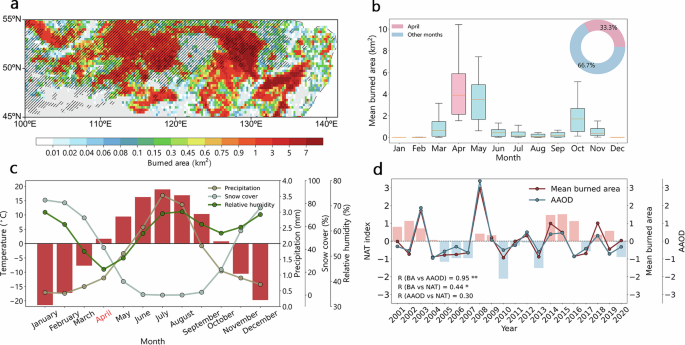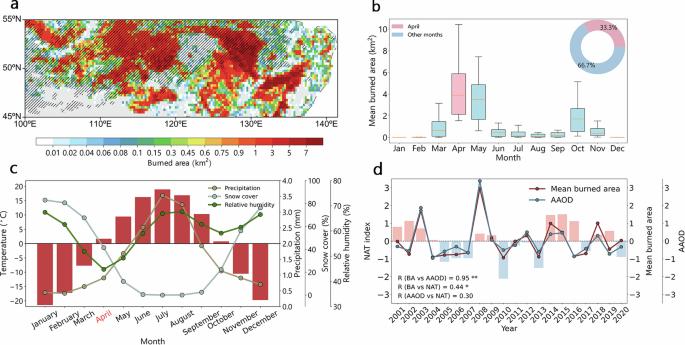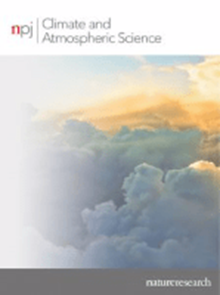深度学习揭示西伯利亚东南部野火升级的未来气候驱动因素
IF 8.5
1区 地球科学
Q1 METEOROLOGY & ATMOSPHERIC SCIENCES
引用次数: 0
摘要
西伯利亚东南部(SES)地区最近在春季经历了越来越大范围的野火,这威胁到了该地区大片森林和泥炭地的巨大碳固存能力。然而,推动火灾增加的根本机制及其对未来气候变化的潜在反应仍不清楚。在此,我们利用再分析数据和气候模式输出以及深度学习模型,探索了正相北大西洋三极(NAT)海面温度异常与SES野火增加之间的关系,并预测了气候变化下SES野火强度的未来趋势。我们发现,4 月正相北大西洋三极海面温度异常增强了西伯利亚反气旋,通过加强暖空气向 SES 地区的平流输送,导致气温升高和融雪增加。后一过程使当地高密度泥炭地更容易受到火源条件的影响,从而导致更密集的野火事件。我们进一步证明,预测的自然通风变化可推动未来 4 月 SES 野火的年代际变化。随着未来全球变暖下自然通风模式的阶段性转变,在 1982-2014 年至 2015-2100 年不同的变暖情景下,SES 的区域平均燃烧面积可能会增加 47-62% 。我们的研究结果揭示了在全球变暖的背景下,中东部地区未来野火的气候驱动升级,并呼吁采取积极而紧迫的火灾管理策略来降低火灾风险。本文章由计算机程序翻译,如有差异,请以英文原文为准。


Future climate-driven escalation of Southeastern Siberia wildfires revealed by deep learning
The Southeastern Siberia (SES) region has recently experienced increasingly extensive wildfires in spring, which have threatened its large carbon sequestration capacity from vast forests and peatlands. However, the underlying mechanisms propelling the increased fires and their potential responses to future climate change remain unclear. Here, by using reanalysis data and climate model output together with a deep learning model, we explore the relationship between positive-phase North Atlantic Tripole (NAT) sea-surface temperature anomalies and SES wildfire increases and project the future trend in SES wildfire intensities under climate change. We found that the positive-phase April NAT enhances the Siberian anticyclone, causing increased temperatures and snowmelt via strengthened transport of warm-air advection into the SES region. The latter process heightens the exposure of local high-density peatlands to favorable conditions for fire ignition and leads to more intensive wildfire incidents. We further demonstrate that the projected NAT variations can drive interdecadal changes in future April SES wildfires. With future phase shifting of NAT modes under global warming, the regionally averaged burned area in SES could be increased by 47–62% under different warming scenarios from 1982–2014 to 2015–2100. Our findings reveal the climate-driven escalation of future wildfires in SES in the context of global warming and call for active and urgent fire management strategies to mitigate the fire risk.
求助全文
通过发布文献求助,成功后即可免费获取论文全文。
去求助
来源期刊

npj Climate and Atmospheric Science
Earth and Planetary Sciences-Atmospheric Science
CiteScore
8.80
自引率
3.30%
发文量
87
审稿时长
21 weeks
期刊介绍:
npj Climate and Atmospheric Science is an open-access journal encompassing the relevant physical, chemical, and biological aspects of atmospheric and climate science. The journal places particular emphasis on regional studies that unveil new insights into specific localities, including examinations of local atmospheric composition, such as aerosols.
The range of topics covered by the journal includes climate dynamics, climate variability, weather and climate prediction, climate change, ocean dynamics, weather extremes, air pollution, atmospheric chemistry (including aerosols), the hydrological cycle, and atmosphere–ocean and atmosphere–land interactions. The journal welcomes studies employing a diverse array of methods, including numerical and statistical modeling, the development and application of in situ observational techniques, remote sensing, and the development or evaluation of new reanalyses.
 求助内容:
求助内容: 应助结果提醒方式:
应助结果提醒方式:


